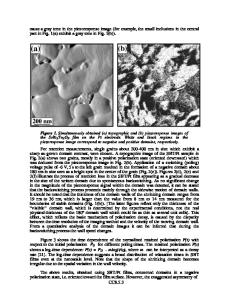Influence of Vanadium Doping on Structural and Ferroelectric Properties of Laser Ablated SrBi 2 Ta 2 O 9 Thin Films
- PDF / 174,868 Bytes
- 6 Pages / 612 x 792 pts (letter) Page_size
- 97 Downloads / 325 Views
Influence of Vanadium Doping on Structural and Ferroelectric Properties of Laser Ablated SrBi2Ta2O9 Thin Films Rasmi R. Das, P. Bhattacharya, W. Pérez and Ram S. Katiyar Physics Department, University of Puerto Rico, San Juan, PR 00931-3343, USA ABSTRACT Pulsed laser deposition technique was used to fabricate SrBi 2Ta2O9 (SBT) thin films with partial replacement of penta-valent vanadium ion. In this report, we have doped certain concentrations (0, 5, 10, 15 %) of vanadium at Ta-site of SBT thin films and study their influence on the structural and electrical characteristics. Thin films were grown on platinized silicon substrates using an excimer laser (KrF, 248 nm) with an energy density of ~ 2.5 J/cm2. Xray diffraction studies confirmed the c-axis suppression of the films at lower processing temperature and at higher annealing temperatures. The decrease in the lattice parameter with vanadium doping was attributed to the smaller ionic radii of vanadium in comparison to Ta. Raman modes of SBT thin films shifted to higher frequencies upon vanadium incorporation at Ta-site. The extra Raman mode observed around ~860 cm-1, was attributed due to the octahedron stretching vibration in the presence of vanadium at the center of octahedral cage. SBT thin films with 5% V doping exhibit enhanced ferroelectric properties, and the ferroelectric properties were degraded for higher vanadium concentration. The SBT thin films show dielectric constant of about ~258 with tangential loss of 0.02 at a frequency of 100 kHz. Dielectric constant decreases with increase in V-concentration and attributed to the interdiffusion of bismuth into platinum electrode. The leakage current density of the films was also increased upon vanadium incorporation in SBT thin films. INTRODUCTION There is a global interest to fabricate non-volatile memory device based on ferroelectric thin films. Recently, bismuth layered ferroelectrics have drawn much interest for memory devices because of having low leakage current density, low operating voltage, fast switching, and fatigue endurance of up to 1012 switching cycles [1,2]. SrBi 2Ta2O9 (SBT) and SrBi 2Nb2O9 (SBN) are most intensively studied ferroelectric compounds in bismuth-layered series due to its fatigue free nature. Sr-deficient and Bi-excess composition Sr0.8Bi2.2Ta2O9 was investigated by Noguchi et al. [3], according to them remanent polarization is doubled (2Pr ~ 23 µC/cm2) compared to stoichiometric SBT, and this enhancement has also been confirmed by several groups [4,5]. There are large numbers of reports on thin films with compositions deviating from the stoichiometry of SBT to enhance the remanent polarization (Pr) and to further decrease the coercive field (Ec) for application of non-volatile random access memory devices [6-8]. The substitution of A- and B-site cations has pronounced influence on ferroelectric properties of SBT thin films [9]. Generally Bi-layered ferroelectrics crystallize at higher temperature. Recently Wu et al. [10] have reported the reduction of processing temperature by par
Data Loading...











